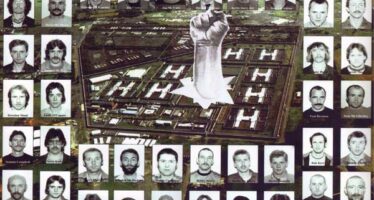ARUNDHATA ROY: GANDHIANI ARMATI
![]()
Il conflitto che imperversa decenni nel cuore dell’ India, quello del Governo contro le popolazioni native minacciate di estinzione dalle politiche economiche neoliberiste, viene messo sotto silenzio dai mass media internazionali. La presenza in quell’area, denominata il “Corridoio Rosso” del movimento naxalita d’ispirazione maoista, ha fatto si che il Governo indiano applicasse la strategia di guerra paramilitare che in epoche recenti fu ed è applicata secondo i dettami dei principi contro insurrezionali elaborati dagli Stati Uniti. In Viet Nam, Guatemala, Colombia, Afghanistan, la strategia ha consisto – e consiste – nell’armare milizie paramilitari, che in India si chiamano Salwa Judum, coordinate con l’esercito per creare i “villaggi strategici” vale dire l’espulsione delle popolazioni dalle terre dove opera in movimento guerrigliero e spingerle verso zone sotto controllo dell’ esercito. Come in Colombia questa strategia ha come obiettivo “liberare” il territorio per le multinazionali che hanno firmato contratti miliardari per l’estrazione di materie prime, minerali soprattutto. Arundhati Roy, scrittrice e attivista indiana, ha vissuto per alcune settimane assieme al movimento naxalita nel profondo della selva della India centrale dove l movimento opera. Una esperienza narrata in un articolo dal titolo “Walking with the Comrades” (camminando con i compagni) pubblicato dalla rivista indiana “Outlook”. L’agenzia alternativa statunitense. “Democracy Now”, ha intervistato Arundhati Roy. Ne riportiamo un breve estratto.
ANJALI KAMAT: Nel suo articolo, descrive la gente con la quale ha viaggiato, i guerriglieri armati, come gandhiani con armi. Può spiegare cosa vuole dire con questo e cosa pensa della violenza perpetrata dai maoisti?
ARUNDHATI ROY: E’ risaputo che sull’argomento c’è un dibattito molto intenso in India, incluso la sinistra dominante e gli intellettuali liberali hanno, molti, molti sospetti sui maoisti. E tutti hanno molti sospetti sui maoisti perché hanno – avevano – un passato difficile e ci sono molte cose che dicono i suoi ideologi che ti provocano brividi. Però quando sono stata con loro, devo dire che sono rimasta molto impressionata da quanto ho potuto vedere, perché penso che negli ultimi trenata anni c’è qualcosa che è cambiato radicalmente tra di loro. E l’importante è che in India la gente cerca di fare la differenza. Dicono che esistono i maoisti e poi che esistono i tribali. I realtà, i maoisti sono tribali, e gli stessi tribali hanno una storia di resistenza e ribellione che precede di secoli Mao. E per questo penso che è solo un nome, in un certo modo. E’solo un nome. Eppure, senza questa organizzazione la gente tribale non avrebbe potuto presentare questa resistenza. Quindi la questione è complicata. Però quando io sono stata là, ho vissuto con loro e camminai con loro per molto tempo, ed è un esercito che è più gandhiano che qualsiasi gandhiano e lascia una traccia più leggera che qualsiasi evangelista del cambio climatico. E come ho detto, incluso le loro tecniche di sabotaggio sono gandhiane. Non sprecano niente. Vivono di niente. E per il mondo esterno – soprattutto i mezzi d’informazione stanno mentendo su di loro da molto tempo. Molti degli episodi di violenza non sono avvenuti, cosa che mi immaginavo. E molti di questi episodi ebbero luogo e ci fu un motivo per cui avvennero. Ciò che io volevo realmente chiedere a questa gente era domandare sualla resistenza non violenta ed io stesso parlavo con loro di questo. Io gli diceveo che le donne saranno le prime vittime di una lotta armata. Ma quando fui a vivere con loro, scoprì che la verità era il contrario. Scoprì che il 50% dei quadri armati sono donne. E gran parte della ragione di questa grande adesione sta nel fatto che per trent’anni i maoisti sono stati a lavorare con donne. L’organizzazione delle donne ha 90.000 aderenti, il che probabilmente significa la più grande organizzazione femminista dell’ India e tutte queste 90.000 donne sono sicuramente maoiste, e il governo si è attribuito il diritto di sparare a prima vista. Quindi, spareranno contro queste 90.000 donne?
Per la versione integrale dell’intervista in inglese:
http://www.democracynow.org/2010/3/22/arundhati_roy_on_obamas_wars_india
Per la versione integrale dell’intervista in spagnolo: http://www.rebelion.org/noticia.php?id=102946
Related Articles
I am proud to be a rebel – Roger Casement by Gerry Adams
![]()
Tuesday was the anniversary of Big Doc’s (Kieran Doherty) death on hunger strike. He died the day after Kevin Lynch
COLOMBIA: POVERTA’ E SEMPRE PIU ARMI
![]()
La Colombia è il paese latinoamericano che ha speso di più nel mercato delle armi, in rapporto al PIB nel
JON SOBRINO. “NEL SUO INSIEME, LA CHIESA TENDE A DISTANZIARSI DA GESU AFFINCHE’ NON DISTURBI”
![]()
GARA. Mi raccontano – scherzando – che Lei è arrabbiato con il mondo e Le ho anche sentito dire più



